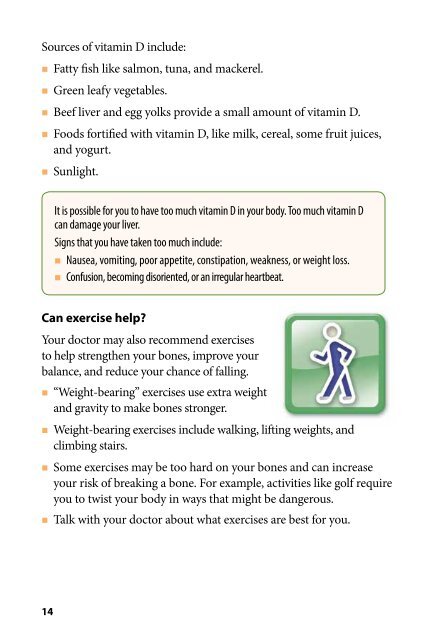Reducing the Risk of Bone Fracture
Reducing the Risk of Bone Fracture - AHRQ Effective Health Care ...
Reducing the Risk of Bone Fracture - AHRQ Effective Health Care ...
You also want an ePaper? Increase the reach of your titles
YUMPU automatically turns print PDFs into web optimized ePapers that Google loves.
Sources <strong>of</strong> vitamin D include:<br />
• Fatty fish like salmon, tuna, and mackerel.<br />
• Green leafy vegetables.<br />
• Beef liver and egg yolks provide a small amount <strong>of</strong> vitamin D.<br />
• Foods fortified with vitamin D, like milk, cereal, some fruit juices,<br />
and yogurt.<br />
• Sunlight.<br />
It is possible for you to have too much vitamin D in your body. Too much vitamin D<br />
can damage your liver.<br />
Signs that you have taken too much include:<br />
• Nausea, vomiting, poor appetite, constipation, weakness, or weight loss.<br />
• Confusion, becoming disoriented, or an irregular heartbeat.<br />
Can exercise help?<br />
Your doctor may also recommend exercises<br />
to help streng<strong>the</strong>n your bones, improve your<br />
balance, and reduce your chance <strong>of</strong> falling.<br />
• “Weight-bearing” exercises use extra weight<br />
and gravity to make bones stronger.<br />
• Weight-bearing exercises include walking, lifting weights, and<br />
climbing stairs.<br />
• Some exercises may be too hard on your bones and can increase<br />
your risk <strong>of</strong> breaking a bone. For example, activities like golf require<br />
you to twist your body in ways that might be dangerous.<br />
• Talk with your doctor about what exercises are best for you.<br />
14




